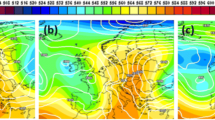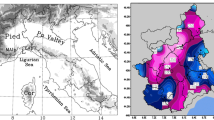Abstract
The three-dimensional compressible non-hydrostatic mesoscale model ADREA, developed at NCSR “Demokritos” for wind field and dispersion predictions in complex terrain, is used to perform two-dimensional simulations of orographically induced precipitation. The model makes use of a simple cartesian grid by allowing blocked areas in the grid volumes and grid faces which are crossed by the irregular topography (the so-called porous-medium concept). Additionally, since we are seeking both simplicity and low computational requirements, only one prognostic equation for the whole of the water substance is implemented. The model equations are based on the theory developed for multicom-ponent/multiphase mixtures and give full account of the effects arising from the relative motion between water particles and moist air. The evaluation of the feasibility of this approach is obtained by comparing model predictions with measurements and analytical results concerning orographic precipitation episodes in the mountain barrier of Sierra Nevada.
Similar content being viewed by others
References
Amanatidis, G. T., Housiadas, C., and Bartzis, J. G.: 1991, ‘Spatial Distribution of Rainfall in the Greater Athens Area’, Meteorol. Mag. 120, 41–50.
Bartzis, J. G.: 1989, ‘Turbulent Diffusion Modelling for Wind Flow and Dispersion Analysis’, Atmos. Environ. 23, 1963–1969.
Bartzis, J. G., Varvayanni, M., Catsaros, N., Konte, K., and Amanatidis, G. T.: 1990, ‘Wind Field and Dispersion Modelling in Complex Terrain’, Commission of the European Communities, Report EUR 13013, Vol. 1, pp. 77–96.
Bartzis, J. G., Venetsanos, A. G., Varvayanni, M., Catsaros, N., and Megaritou, A.: 1991, ‘ADREA-I: A Transient Three Dimensional Transport Code for Complex Terrain and Other Applications’, Nucl. Technol. (in press).
Bird, R. B., Stewart, W. K., and Lightfoot, E. N.: 1960, Transport Phenomena, John Wiley & Sons, Inc., New York.
Colton, D. E.: 1976, ‘Numerical Simulation of the Orographically Induced Precipitation Distribution for Use in the Hydrologic Analysis’, J. Appl. Meteorol. 15, 1241–1251.
Cotton, W. R. and Anthes, R. A.: 1984, The Dynamics of Clouds and Mesoscale Meteorological Systems. Vol. I: The Dynamics of Clouds, Academic Press, New York.
Deardorff, J. W.: 1976, ‘Usefulness of Liquid-Water Potential Temperature in Shallow-Cloud Model’, J. Appl. Meteorol. 15, 98–102.
Dobran, F.: 1985, ‘Theory of Multiphase Mixtures. A Thermomechanical Formulation’, Int. J. Multiphase Flow 11, 1–30.
Dutton, J. A.: 1976, The Ceaseless Wind. An Introduction to the Theory of Atmospheric Motion, McGraw-Hill, New York.
Elliot, R. D. and Shaffer, R. W.: 1962, ‘The Development of Quantitative Relatiohships between Orographic Precipitation and Airmass Parameters for use in Forecasting and Cloud Seeding Evaluation’, J. Appl. Meteorol. 1, 143–154.
Gross, G.: 1986, ‘A Numerical Study of the Land and See Breeze Including Cloud Formation’, Contrib. Atmos. Phys. 59, 97–114.
Hales, J. M.: 1989, ‘A Generalised Multidimensional Model for Precipitation Scavenging and Atmospheric Chemistry’, Atmos. Environ. 23, 2017–2031.
Ishii, M.: 1975, Thermo-Fluid Dynamic Theory of Two-Phase Flows, Eyrolles, Paris.
Ishii, M.: 1977, One-Dimensional Drift Flux Model and Constitutive Equations for Relative Motion Between Phases in Various Two-Phase Flow Regimes, Argonne National Laboratory, Illinois, Report ANL-77–47.
Kessler, E.: 1969, On the Distribution and Continuity of Water Substance in Atmospheric Circulations, Meteorol. Monogr. 32.
Kreitzberg, C. W. and Perkey, D. J.: 1977, ‘Release of Potential Instability: Part II. The Mechanism of Convective/Mesoscale Interaction’, J. Atmos. Sci. 34, 1569–1595.
Lin, Y. L., Parley, R. D., and Orville, H. D.: 1983, ‘Bulk Parameterization of the Snow Field in a Cloud Model’, J. Clim. Appl. Meteorol. 22, 1065–1092.
Nickerson, E. C., Richard, E., Rosset, R., and Smith, D. R.: 1986, ‘The Numerical Simulation of Counds, Rain, and Airflow over the Vosges and Black Forest Mountains: A Meso-βModel with Parameterized Microphysics’, Mon. Weather Rev. 114, 398–414.
Ogura, Y. and Takahashi, T.: 1971, ‘Numerical Simulation of the Life Cycle of a Thunderstorm Cell’, Mon. Weather Rev. 99, 895–911.
Patankar, S. V.: 1980, Numerical Heat Transfer and Fluid Flow, Hemisphere Publishing Corporation.
Pielke, R. A.: 1984, Mesoscale Meteorological Modeling, Academic Press, New York.
Richard, E. and Chaumerliac, N.: 1989. ‘Effects of Different Rain Parameterizations on Simulation of Mesoscale Orographic Precipitation’, J. Appl. Meteorol. 28. 1197–1212.
Rosten, H. I. and Spalding, D. B.: 1987, The Phoenics Beginner's Guide, CHAM Limited, England, Report Number TR/100.
Sha, W. T., Domanus, H. M., Schmitt, R. C., Oras, J. J., and Lin, E. I. H.: 1978, ‘Commix-1: A Three-Dimensional Transient Single-Phase Component Computer Program for Thermal-Hydraulic Analysis’, Argonne National Laboratory, Illinois. Report ANL-82–25, Vol. I, also: ibid, Sha, W. T., Domanus, H. M., Schmitt, R. C., Oras, J. J., and Lin, E. I. H.: 1978, Commix-1: A Three-Dimensional Transient Single-Phase Component Computer Program for Thermal-Hydraulic Analysis, U.S. Nuclear Regulatory Commission, Report NUREG/CR-2896, Vol. I.
Singhal, A. K., Keeton, L. W. Spalding, D. B., and Srikantiah, G. S.: 1982, ‘Athos-A Computer Program for Thermal-Hydraulic Analysis of Steam Generators. Vol. 1: Mathematical and Physical Models and Methods of Solution’, Electric Power Research Institute, California, Report EPRI NP-2698-CCM.
Smith, R. B.: 1979, ‘The Influence of Mountains on the Atmosphere’, Adv. Geophys. 21, 87–230.
Soo, S. L.: 1967. Fluid Dynamics of Multiphase Systems, Blaisdell Publishing Company.
Tripoli, G. J. and Cotton, W. R.: 1981, ‘The Use of Ice-Liquid Liquid Water Potential Temperature as a Thermodynamic Variable in Deep Atmospheric Models’, Mon. Weather Rev. 109, 1094–1102.
Wulff, W.: 1990, ‘Computational Methods for Multiphase Flow’, in: Hewitt, G. F., Delhaye, J. M., and Zuber, N. (eds.). Multiphase Science and Technology, Vol. 5, Hemisphere Publishing Corporation, pp. 85–238.
Author information
Authors and Affiliations
Rights and permissions
About this article
Cite this article
Housiadas, C., Amanatidis, G.T. & Bartzis, J.G. Prediction of orographic precipitation using cartesian coordinates and a single prognostic equation for the water substance. Boundary-Layer Meteorol 56, 245–260 (1991). https://doi.org/10.1007/BF00120422
Accepted:
Issue Date:
DOI: https://doi.org/10.1007/BF00120422




